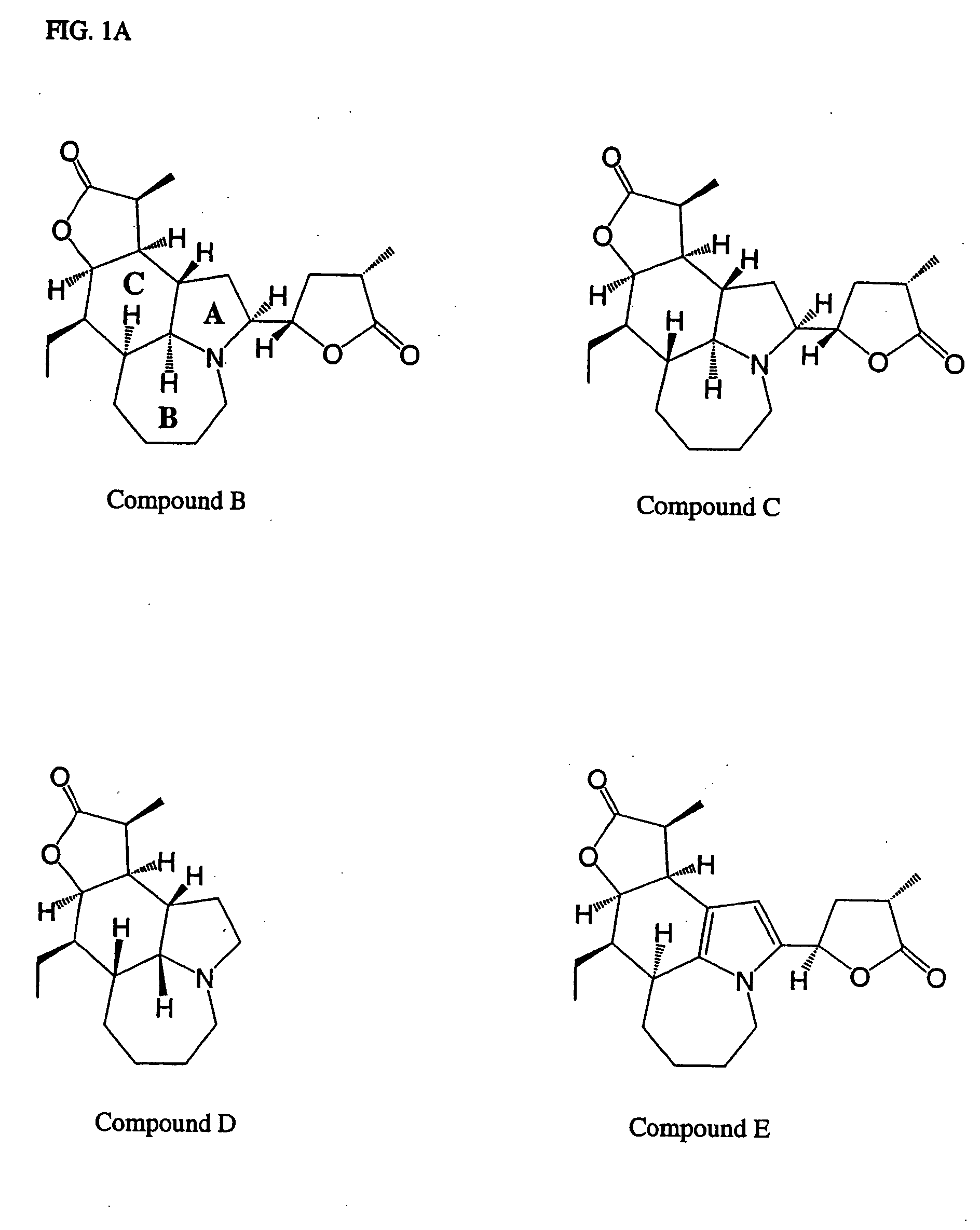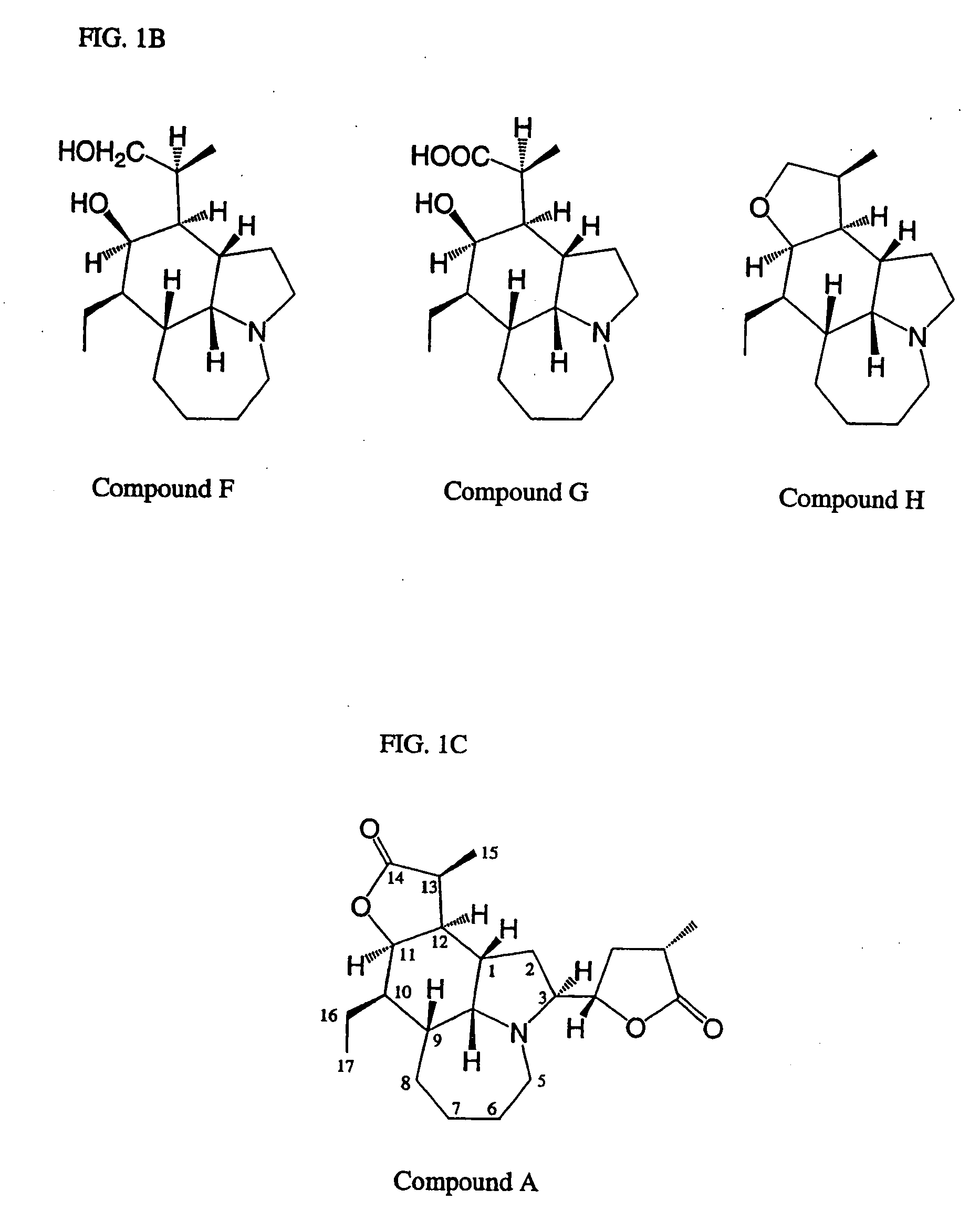Plant extracts and alkaloids having antitussive activity
a technology of plant extracts and alkaloids, which is applied in the field of plant extracts, isolated plant alkaloids, and synthetic alkaloids, can solve the problems of many chemical agents causing coughing, mechanical difficulties may arise, and many chemical agents can cause coughing
- Summary
- Abstract
- Description
- Claims
- Application Information
AI Technical Summary
Benefits of technology
Problems solved by technology
Method used
Image
Examples
example 1
[0082] Production of Aqueous Extract
[0083] Dried root tubers of Stemona tuberosa (10 g) were chopped into small pieces and extracted with distilled water under reflux for 2 hr. After filtration the water solution was evaporated to dryness to yield a aqueous extract (3.5 g).
example 2
[0084] Production of Total Alkaloid Extract
[0085] To obtain a total alkaloid extract, 6 kg of dried root tubers of Stemona tuberosa was chopped into small pieces and refluxed with 95% ethanol for 2 hr. The warm extract liquor was poured out and allowed to stand overnight at 10° C. Thereafter, the liquor was filtered, and the filtrate evaporated under reduced pressure to obtain a syrup. The syrup was acidified with diluted hydrochloride solution (4%) and centrifuged at 3000 RPM, 5° C, for 40 min. The supernatant was basified with aqueous ammonium hydroxide to pH 9 and sequentially extracted with diethyl ether and chloroform, respectively. The combined organic solution was then evaporated to dryness resulting in a total alkaloid extract (24 g).
example 3
[0086] Isolation of Five Stemona Alkaloids (Compounds A-E)
[0087] The total alkaloid extract (24 g) of Example 2 was dissolved in diethyl ether with refluxing, then left overnight at room temperature, to give a light yellow precipitate, the crude compound A (3.4 g). The crude compound A was further crystallized with ethanol resulting in a pure alkaloid (Compound A, 2.5 g). The combined mother liquor was evaporated to dryness, to form a mixture of alkaloids. The mixture of alkaloids was then subjected to silica gel column chromatography, and eluted successively with a discontinuous gradient solvent of CHCl3:MeOH:NH4OH (98:2:0.05), (96:4:0.05) and (92:8:0.05), respectively. The eluant was monitored by Thin Layer Chromatography (TLC) and pooled into four fractions 1-4. Fraction 1 (0.9 g) eluted with CHCl3:MeOH:NH4OH (98:2:0.05) was further purified by silica gel column chromatography with hexane-EtOAc (70:30) elution to yield compound E (Eipbisdehydrotuberostemonine J, 380 mg). Fractio...
PUM
| Property | Measurement | Unit |
|---|---|---|
| body weight | aaaaa | aaaaa |
| temperature | aaaaa | aaaaa |
| pH | aaaaa | aaaaa |
Abstract
Description
Claims
Application Information
 Login to View More
Login to View More - R&D
- Intellectual Property
- Life Sciences
- Materials
- Tech Scout
- Unparalleled Data Quality
- Higher Quality Content
- 60% Fewer Hallucinations
Browse by: Latest US Patents, China's latest patents, Technical Efficacy Thesaurus, Application Domain, Technology Topic, Popular Technical Reports.
© 2025 PatSnap. All rights reserved.Legal|Privacy policy|Modern Slavery Act Transparency Statement|Sitemap|About US| Contact US: help@patsnap.com



